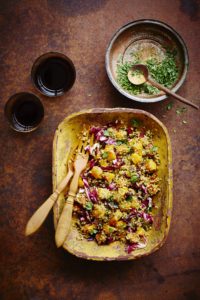 Author Laura Agar Wilson (@lauraagarwilson, pictured right) is a Certified Health Coach having trained with the Institute of Integrative Nutrition where she studied more than 100 dietary theories, practical lifestyle management techniques and innovative coaching methods. She holds a qualification in diet and nutrition advice, neurolinguistic programming (NLP) and cognitive behavioural therapy (CBT) and is a member of the Federation of Holistic Therapists. In 2015, some of her work looking at diet and a healthy lifestyle was published in Grains As Mains from Dorling Kingsley.
Author Laura Agar Wilson (@lauraagarwilson, pictured right) is a Certified Health Coach having trained with the Institute of Integrative Nutrition where she studied more than 100 dietary theories, practical lifestyle management techniques and innovative coaching methods. She holds a qualification in diet and nutrition advice, neurolinguistic programming (NLP) and cognitive behavioural therapy (CBT) and is a member of the Federation of Holistic Therapists. In 2015, some of her work looking at diet and a healthy lifestyle was published in Grains As Mains from Dorling Kingsley.
It aims to satisfy anyone’s appetite for tasty, versatile and healthy grains. It contains more than 150 recipes, many of which are gluten-free. The book particularly focuses on ‘ancient grains’ such as teff, quinoa and buckwheat. These used to be cooked thousands of years ago and are now very much back on the menu. Says Agar Wilson, “These grains are great for us, nutritious, protein-rich and have excellent textures too.”
 The term ancient grains describes a number of grains or seeds that are enjoying a resurgence in popularity, but which in fact have been grown and eaten for hundreds of thousands of years by different cultures around the world. Some of these grains, such as cornmeal (polenta) and wheat, are used readily in modern cooking. Others seem a little unfamiliar though are increasingly being included in food magazine coverage and recipes. In some homes, they will be more familiar – teff will be better known by anyone with north African connections, while kamut will be familiar to people who have come from or travelled to Egypt. Some grains, such as farro, are known to date back to ancient Egypt, when it was used in bread making.
The term ancient grains describes a number of grains or seeds that are enjoying a resurgence in popularity, but which in fact have been grown and eaten for hundreds of thousands of years by different cultures around the world. Some of these grains, such as cornmeal (polenta) and wheat, are used readily in modern cooking. Others seem a little unfamiliar though are increasingly being included in food magazine coverage and recipes. In some homes, they will be more familiar – teff will be better known by anyone with north African connections, while kamut will be familiar to people who have come from or travelled to Egypt. Some grains, such as farro, are known to date back to ancient Egypt, when it was used in bread making.
Nowadays, grains are produced and harvested all across the world, and many can still be found in the areas from which they originated. Amaranth and quinoa originated, and are mostly grown, in South American regions; kamut and farro originated in Egypt; teff and barley are from Ethopia; and millet mainly from Africa and Asia.
Star ingredients
This comprehensive cookbook shows you how to prepare and cook key ancient grains, from slightly more familiar grains like quinoa and polenta, to more unexpected ones, like teff and kamut. The recipes use grains as the star ingredient for satisfying main meals, though many can easily be used as sides or salads.
 The upside for any one with diabetes is that most of these ancient grains have a lower glycaemic index than more commonly available examples, such as white rice or processed flours from grains that have often lost a bit of goodness along the way.
The upside for any one with diabetes is that most of these ancient grains have a lower glycaemic index than more commonly available examples, such as white rice or processed flours from grains that have often lost a bit of goodness along the way.
Half the fun is exploring the range of hearty and healthy recipes gathered and inspired from around the world, often in places where these grains are more everyday than here in the UK. Whole grains are by far the best source of energy from a carbohydrate food.
With many also high in fibre and protein (quinoa and amaranth are complete
proteins, meaning that they are great alternatives to meat), these grains deliver the consistent energy we need, but they also come with a variety of nutrients and health benefits. Grains are low-fat, complex carbohydrates, making you feel satisfied for longer, and they can help to maintain a healthy weight by curbing craving and the desire to overeat.
Many ancient grains are gluten-free and are completely safe for people who are gluten intolerant. If someone has mild gluten intolerance, they may also be able to eat some of the other grains, such as spelt, but for those with a more severe gluten intolerance, such as coeliac sufferers, only choose grains that are said to be from a dedicated gluten-free facility.
Carbohydrate content of some ancient grains per 45g dry (uncooked) portion: amaranth 30g, barley 34g, buckwheat 32g, faro 34g, freekah, 32g, kamut 32g, quinoa, 30g, spelt 30g, teff 32g.
News items and features like this appear in the Desang Diabetes Magazine, our free-to-receive digital journal. We cover diabetes news, diabetes management equipment (diabetes kit) and news about food suitable for a diabetic diet. Go to the top of this page to sign up – we just need your email address.



